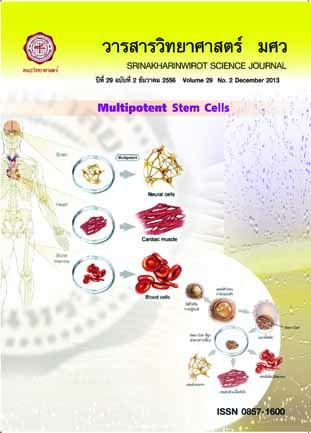การพัฒนามัฟฟินเนื้อตาลสุก Development of Palmyra Palm Muffin
Keywords:
เนื้อตาล มัฟฟิน เบเกอรี่ ขนมอบ การพัฒนาผลิตภัณฑ์ Palmyra palm, muffin, bakery, baked goods, product developmentAbstract
การวิจัยครั้งนี้มีวัตถุประสงค์เพื่อศึกษาสูตร คุณภาพทางเคมีการยอมรับของผู้บริโภค และต้นทุนการผลิตของมัฟฟินเนื้อตาลสุกดำเนินการทดลองโดยศึกษา 1) การใช้ปริมาณเนื้อตาลสุกที่เหมาะสมในมัฟฟิน2) วิเคราะห์คุณภาพทางกายภาพ เคมีและประสาทสัมผัสด้วยวิธีให้คะแนนความชอบ 9-point hedonic scale 3) คัดเลือกสูตรของมัฟฟินเนื้อตาลสุกที่ผู้ทดสอบให้คะแนนความชอบสูงสุดมาศึกษาการยอมรับของผู้บริโภคและ 4) ศึกษาต้นทุนการผลิต สถิติที่ใช้ในการวิเคราะห์ได้แก่ค่าเฉลี่ย วิเคราะห์ความแปรปรวน (Analysis of Variance) และทดสอบความแตกต่างด้วยค่าF-test เปรียบเทียบความแตกต่างของค่าเฉลี่ยด้วย Duncan’s New Multiple Range Test (DMRT) กำหนดนัยสำคัญทางสถิติที่ระดับความเชื่อมั่นร้อยละ 95 ผลการวิจัยพบว่าการเพิ่มปริมาณเนื้อตาลสุกมีผลให้มัฟฟินมีสีเหลืองเข้มขึ้น มีขนาดชิ้น ความแข็งและความชื้นเพิ่มขึ้น สูตรที่เหมาะสมของมัฟฟินเนื้อตาลสุกประกอบด้วยแป้งสาลีเอนกประสงค์ ผงฟู เนยสด น้ำตาลทราย เกลือป่น ไข่ไก่ นมสด กลิ่นวานิลา และเนื้อตาลสุกร้อยละ 29.51, 2.49, 12.88, 19.12, 0.33, 10.39, 14.96, 0.33 และ 9.98 ของน้ำหนักทั้งหมดตามลำดับผลการศึกษาคุณภาพทางเคมีของมัฟฟิน 100กรัมพบว่ามัฟฟินเนื้อตาลสุกประกอบด้วยความชื้น โปรตีน ไขมัน เถ้า เยื่อใยและคาร์โบไฮเดรตร้อยละ 25.75, 5.56, 13.50, 2.32, 0.72 และ 52.15 ตามลำดับ มีพลังงานทั้งหมด 352.34 กิโลแคลอรี่ และเบต้าแคโรทีน 102.53 ไมโครกรัม เมื่อทดสอบการยอมรับของผู้บริโภคพบว่าผู้บริโภคให้คะแนนความชอบมัฟฟินเนื้อตาลสุกในระดับชอบมาก และให้การยอมรับร้อยละ 96มัฟฟินเนื้อตาลสุกนี้มีต้นทุนการผลิตต่อชิ้นเท่ากับ 1.49 บาทThe objectives of thisresearch were to study the formula, chemical quality, consumer acceptance andproduction cost of the Palmyra palm muffin. The experimental processes weredesigned: 1) to optimize the quantity of Palmyra palm in muffin mixture; 2) toanalyze the quality of physical, chemical and sensory evaluations by using thepreference test with a 9-point hedonic scale; 3) to select the muffin which theoverall liking was at the highest level for the consumer acceptance test and 4)to determine the cost of production. The statistical analysis of data consistedof means, analysis of variance and different test by F-test. Duncan’s New Multiple Range Test (DMRT) wasused to compare the difference of means. Statistical significance was set atthe confidence level of 95%. The results indicated that the yellowness (b*)values of crust and crumb, size, hardness and moisture increased with thequantity of ripe Palmyra palm. The appropriate formula of Palmyra palm muffinwas composed of 29.51% all-purpose flour, 2.49% baking powder, 12.88% butter,19.12% sugar, 0.33% salt, 10.39% egg, 14.96% milk, 0.33% vanilla flavor and9.98% ripe Palmyra palm. The results of chemical quality in 100 g Palmyra palm muffin showedthe moisture, protein, fat, ash, fiber and carbohydrate were 25.75%, 5.56%,13.50%, 2.32%, 0.72% and 52.15%, respectively. Total calorie and beta-carotenewere 352.34 kcal and 102.53 µg, respectively. Consumer acceptability testrevealed that the overall liking of Palmyra palm muffin was the level of likevery much and 96% of consumers accepted this product. Theproduction cost for a piece of the Palmyra palm muffin was 1.49 Baht.Downloads
Download data is not yet available.
Downloads
Published
2013-11-09
How to Cite
ฉายศิริโชติ ธ., & ศิริพันธ์วัฒนา จ. (2013). การพัฒนามัฟฟินเนื้อตาลสุก Development of Palmyra Palm Muffin. Science Essence Journal, 29(2). Retrieved from https://ejournals.swu.ac.th/index.php/sej/article/view/3615
Issue
Section
Research Article








